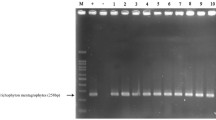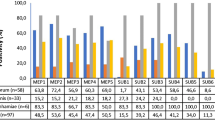Abstract
This study first report to identify the mating type (−)-specific gene of alpha-box and the mating type (+)-specific gene of the high-mobility-group (HMG) DNA-binding domain in zoophilic dermatophytes of Arthroderma benhamiae in an effort to understand the epidemiological characteristics of Trichophyton mentagrophytes. The sequence of the alpha-box gene (1,387 bp) was found to contain two exons, from 184 to 475 bp and from 525 to 1,387 bp, coding a protein of 384 amino acids, beginning with a putative initiating methionine (ATG). The sequence of the HMG gene (1,910 bp) contained two exons, from 234 to 415 bp and from 479 to 1,457 bp, coding a protein of 386 amino acids, beginning with a putative initiating methionine (ATG).
PCR analysis detected the alpha-box gene in A. benhamiae (−) mating type strains but not in (+) mating type strains. On the other hand, the HMG gene was detected in A. benhamiae (+) mating type strains but not in (−) mating type strains. These findings suggest that the HMG and alpha-box genes could be specific to the (+) and (−) mating types, respectively.



Similar content being viewed by others
References
Casselton LA. Fungal sex genes-searching for the ancestors. BioEssays. 2008;30:711–4.
Bubnick M, Smulian AG. The MAT1 locus of Histoplasma capsulatum is responsive in a mating type-specific manner. Eukaryotic Cell. 2007;6:616–21.
Kwon-Chung KJ, Bennett EJ. Medical mycology. Philadelphia: Lea & Febiger; 1992. pp.136-7 and 816-26.
Li W, Metin B, White TC, Heitman J. Organization and evolutionary trajectory of the mating type (MAT) locus in the dermatophyte and dimorphic pathogen. Eukaryotic Cell. 2009;6:616–21.
Ajello L, Cheng S-L. The perfect state of Trichophyton mentagrophytes. Sabouraudia. 1967;4:230–4.
Stockdale MP, Mackenzie WRD, Austwick KCP. Arthroderma simii sp. nov., the perfect state of Trichophyton simii (Pinoy) comb. nov. Sabouraudia. 1967;4:112–23.
Takashio M. The Trichophyton mentagrophytes complex. In: Iwata K, editor. Recent advances in medical and veterinary mycology. Tokyo: University of Tokyo Press; 1977. p. 271–6.
Bialek R, Ibricevic A, Fothergill A, Begerow D. Small subunit ribosomal DNA sequence shows Paracoccidioides brasiliensis closely related to Blastomyces dermatotidis. J Clin Microbiol. 2000;34:3190–3.
Leclerc CM, Philippe H, Guého E. Phylogeny of dermatophytes and dimorphic fungi based on large subunit ribosomal RNA sequence comparisons. J Med Vet Mycol. 1994;32:331–41.
Kano R, Nakamura Y, Watanabe S, Hasegawa A. Chitin synthase 1 and 2 genes of dermatophytes. Stud Mycol. 2002;47:49–56.
Kawasaki M, Anzawa K, Takeda K, et al. Genetic and phenotypic variation among F1 progenies of Arthroderma benhamiae. Jpn J Med Mycol. 2008;49:103–10.
Acknowledgments
This study was supported by Grants-in-Aid from the Academic Frontier Project of the Japanese Ministry of Education, Culture, Sports, Science and Technology (MEXT) and Nihon University.
Author information
Authors and Affiliations
Corresponding author
Rights and permissions
About this article
Cite this article
Kano, R., Yamada, T., Makimura, K. et al. Arthroderma benhamiae (The Teleomorph of Trichophyton mentagrophytes) Mating Type-Specific Genes. Mycopathologia 171, 333–337 (2011). https://doi.org/10.1007/s11046-010-9383-5
Received:
Accepted:
Published:
Issue Date:
DOI: https://doi.org/10.1007/s11046-010-9383-5




